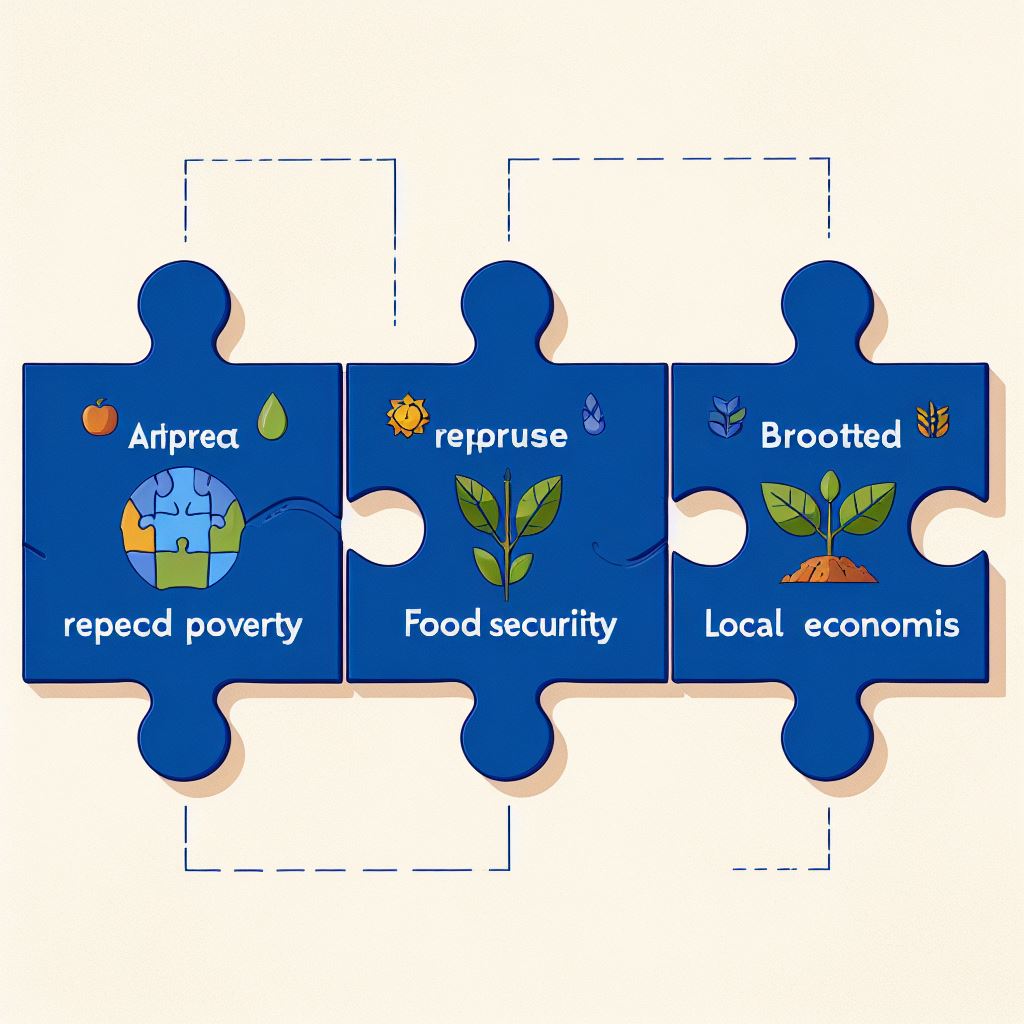Three Key Impacts of SNAP on Economic Stability

Did you know that the Supplemental Nutrition Assistance Program (SNAP) has a significant impact on economic stability?
With over 38 million Americans relying on SNAP benefits, this program plays a crucial role in providing access to nutritious food, promoting employment opportunities, and reducing poverty rates.
By ensuring economic stability and growth, SNAP not only improves the quality of life for individuals and families but also contributes to the overall well-being of our society.
Let’s explore the three key impacts of SNAP on economic stability.
Key Takeaways
- SNAP stimulates local economies by increasing consumer spending.
- Every $1 billion in SNAP benefits generates $1.54 billion in economic activity.
- SNAP benefits support grocery stores, farmers, and food manufacturers.
- SNAP stabilizes the finances of low-income individuals and families during times of hardship.
Access to Nutritious Food
You can improve your access to nutritious food through the Supplemental Nutrition Assistance Program (SNAP). SNAP is a federal assistance program in the United States that provides eligible low-income individuals and families with funds to purchase food. Access to nutritious food is essential for maintaining good health and well-being. Research has shown that SNAP participants have better access to a variety of healthy foods compared to non-participants. According to the USDA, SNAP households spent more of their food budget on fruits, vegetables, and proteins, and less on sugary beverages and snacks. This indicates that SNAP helps individuals make healthier food choices and improves their overall diet quality.
Furthermore, SNAP has been found to reduce food insecurity among its participants. Food insecurity refers to the lack of consistent access to enough food for an active, healthy life. Studies have shown that SNAP participation is associated with lower rates of food insecurity and hunger. In fact, a report from the Center on Budget and Policy Priorities found that SNAP reduces the prevalence of very low food security by about 30%. This demonstrates that SNAP plays a vital role in ensuring that individuals and families have access to enough food to meet their nutritional needs.
In addition to improving access to nutritious food, SNAP also has positive economic impacts. It has been found to stimulate local economies by increasing consumer spending and creating jobs. A study by the USDA Economic Research Service estimated that every $1 billion in SNAP benefits generates $1.54 billion in economic activity. This is because SNAP benefits are spent on food, which supports grocery stores, farmers, and food manufacturers. Thus, SNAP not only improves food access for participants but also has broader economic benefits for communities.
Promoting Employment Opportunities
To promote employment opportunities, SNAP actively encourages recipients to seek and maintain gainful employment. The Supplemental Nutrition Assistance Program (SNAP) recognizes that employment is a key factor in achieving economic stability and self-sufficiency. By providing support to individuals and families facing food insecurity, SNAP aims to not only alleviate hunger but also empower recipients to secure stable employment and improve their overall economic well-being.
SNAP’s Employment and Training (E&T) program plays a crucial role in promoting employment opportunities. Through this program, recipients are connected with job training, education, and supportive services to enhance their employability. E&T programs vary by state, but they often include initiatives like job search assistance, vocational training, and work experience programs. In 2019, around 2.8 million SNAP participants received E&T services, with many reporting positive outcomes such as increased employment and earnings.
Research shows that participating in SNAP can have a positive impact on employment outcomes. A study conducted by the USDA found that SNAP recipients who participated in E&T programs were more likely to be employed and had higher earnings compared to non-participants. Furthermore, SNAP recipients who secured employment experienced a reduction in their reliance on public assistance programs, contributing to long-term economic stability.
Reducing Poverty Rates
SNAP’s focus on promoting employment opportunities through E&T programs contributes to a significant reduction in poverty rates among low-income households. Here are four key ways in which SNAP helps to reduce poverty:
- Increased income: By providing eligible households with additional funds to purchase food, SNAP helps to alleviate financial strain and increase disposable income. This extra income can be used to cover other essential expenses, such as housing and utilities, which in turn helps to reduce the poverty rates among low-income households.
- Improved food security: SNAP ensures that low-income households have access to nutritious food, which is essential for overall well-being. By addressing food insecurity, SNAP helps to reduce the financial burden of purchasing food and allows households to allocate their limited resources towards other necessities, thus lifting them out of poverty.
- Stimulated local economies: SNAP benefits are spent at local grocery stores and farmers markets, which stimulates economic activity in communities. This increased spending not only supports local businesses but also creates jobs, thereby reducing poverty rates by providing employment opportunities.
- Social safety net: SNAP acts as a critical safety net for low-income households, providing a buffer against economic shocks and helping to prevent individuals and families from falling into poverty. By offering assistance during times of financial hardship, SNAP plays a vital role in reducing poverty rates and promoting economic stability.
Through its focus on promoting employment opportunities and addressing food insecurity, SNAP plays a significant role in reducing poverty rates among low-income households. By increasing income, improving food security, stimulating local economies, and acting as a social safety net, SNAP helps to lift individuals and families out of poverty and create a more stable and prosperous society.
Economic Stability and Growth
The impact of SNAP on economic stability and growth can be seen in several key areas.
Firstly, SNAP provides a safety net for low-income individuals and families, which helps stabilize their finances during times of hardship. By ensuring access to food, SNAP reduces the financial strain on households, allowing them to allocate resources to other essential needs, such as housing and healthcare. This stability creates a foundation for economic growth by enabling individuals to participate in the workforce and contribute to the economy.
Secondly, SNAP has a positive effect on local economies. When individuals use their SNAP benefits, they inject money into the economy, supporting local businesses and stimulating economic activity. Research shows that every dollar spent on SNAP generates $1.50 to $1.80 in economic activity. This multiplier effect not only boosts local businesses but also creates jobs, leading to overall economic growth.
Lastly, SNAP helps prevent economic downturns. During times of recession or economic instability, SNAP serves as an automatic stabilizer. When people face job losses or reduced incomes, SNAP provides immediate assistance, helping to maintain consumer spending levels and preventing further economic decline. This stabilizing effect helps mitigate the impact of economic shocks and contributes to overall economic stability and growth.
Improving Quality of Life for Americans
SNAP significantly enhances the well-being of Americans by improving their quality of life. Here are four key ways in which SNAP positively impacts the lives of individuals and families:
- Reduced food insecurity: SNAP helps ensure that individuals and families have access to nutritious food, reducing the risk of hunger and malnutrition. Research shows that SNAP participation leads to a significant decrease in food insecurity rates, providing a safety net for vulnerable populations.
- Improved health outcomes: By providing access to healthy food options, SNAP contributes to improved health outcomes. Studies have found that SNAP recipients have better overall health, lower rates of chronic diseases like diabetes and high blood pressure, and improved mental well-being.
- Enhanced educational attainment: Adequate nutrition is crucial for cognitive development, especially in children. SNAP helps alleviate food insecurity, allowing children to focus better in school and perform academically. Research indicates that SNAP participation is associated with higher graduation rates and improved educational outcomes.
- Boosted economic mobility: SNAP acts as a bridge for individuals and families during times of financial instability, helping them meet their basic needs and stay afloat. By reducing the burden of food expenses, SNAP frees up resources that can be used for other essential needs like housing, transportation, and healthcare, ultimately improving economic stability and mobility.
Frequently Asked Questions
How Does SNAP Impact the Overall Health and Well-Being of Individuals and Families?
SNAP impacts your overall health and well-being by providing essential nutrition assistance. It helps alleviate food insecurity, reduces poverty rates, and improves dietary quality, leading to better physical and mental health outcomes for individuals and families.
What Strategies Are Being Implemented to Ensure That SNAP Recipients Have Access to Fresh and Nutritious Food Options?
To ensure SNAP recipients have access to fresh and nutritious food, strategies like mobile farmers markets, community gardens, and incentives for purchasing fruits and vegetables are being implemented. These efforts aim to improve food security and promote healthier choices.
Can SNAP Help Individuals Transition Out of Poverty and Achieve Long-Term Economic Stability?
SNAP can indeed help you transition out of poverty and achieve long-term economic stability. It provides vital assistance in purchasing food, freeing up resources for other expenses and potentially boosting your ability to find better employment opportunities.
How Does SNAP Contribute to Local Economies and Stimulate Economic Growth?
SNAP, also known as food stamps, supports local economies by increasing household spending and generating jobs. It stimulates economic growth by providing individuals with purchasing power, which in turn creates demand for goods and services.
Are There Any Additional Benefits or Services Provided Through SNAP That Aim to Improve the Quality of Life for Americans Beyond Food Assistance?
There are indeed additional benefits and services provided through SNAP that aim to improve the quality of life for Americans beyond food assistance. These include nutrition education, employment and training programs, and access to healthcare services.



